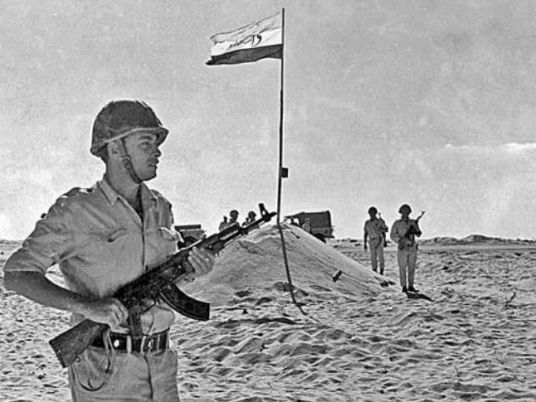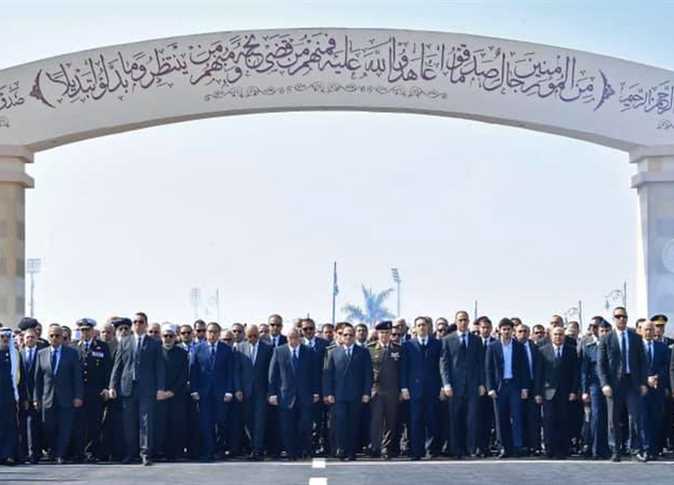War—what is it good for? In the case of the October War Panorama, the answer is, “a few good laughs.” It may be the country’s biggest tribute to its greatest military victory, but like many Egyptian institutions, the October War Panorama is marred by an almost surreal level of incompetence.
According to the back of the entry ticket, “our heroes had recorded history, therefore it is a must to record their struggle.” These noble intentions are countered by the remaining text, which unintentionally mocks that which it sets out to celebrate. Casual visitors would most likely be unaware that the Egyptian army succeeded in “the crossing of the most difficult water Parrier in the world Thanks to our strong Pelief in God,” or that the October War is considered to be “the greakest tanks battles hattipc in the modern history.” These fun facts and misspellings should caution any visitor who wants to learn something; the October War Panorama might not be the place for such a lofty goal.
Visitors arriving before the Panorama’s scheduled show times are led to an outdoor waiting area lined with kiosks selling cheap toys and trinkets, fake jewelry and stickers, as well as burgers, ice cream and popcorn—in short, nothing even remotely related to the October War, or any form of military operation. The only exception is an elderly vendor selling pixilated images of Mubarak and former presidents, alongside images of soccer players, pop idols and WWF stars of the early nineties (Razor Ramon!).
The day’s visit to the Panorama coincided with a school field trip, and, oddly, a 27th birthday party. When asked why he chose to celebrate his birthday at a war museum, Yehia replied, with his mouth full of chocolate cake, “Why not?” Another patron, Haj Hassan, a 54-year-old farmer from Ismailia, brought his six children so that they could learn about “The Great Victory.”
The Panorama’s waiting area and main building are separated by an outdoor gallery of war vehicles and weaponry, including tanks, fighter jets and Gatling guns, the majority of which have been freshly (and sloppily) painted in a single flat shade of military green, effectively concealing any sense of historic worth.
The few unpainted pieces seem to have sustained more damage from being on display than on the battlefield; like the base of the Giza pyramids and any public statue in Cairo, these artifacts serve as bulletin boards for love poems, limericks, anti-Israel slogans and the occasional phallic illustration. However, that did not dissuade the schoolchildren from climbing all over them and neither, for that matter, did the security guards, tour guide or school teachers. From her spot in the shade, one teacher did yell out a warning about the displays being electrically charged, which the children ignored.
Commissioned by President Mubarak and built by Koreans over the course of five years, the simple, circular architecture of the Panorama is not particularly impressive. Once inside, visitors are led along the curved wall, and past a display of granite busts, paintings and murals relating to the war, but this indoor gallery quickly loses its focus; at the end, these tributes are mostly replaced by crafts for sale, including a statue of a beagle and a magazine rack, as well as assorted posters of celebrities and–why not–Spider Man.
The full Panorama experience consists of three separate shows, each approximately 20 minutes long. The first show begins with a short documentary called “The Road to Victory.” Because the sound and picture quality have long since deteriorated past the point of comprehension, “The Road to Victory” is impossible to follow and a little painful to look at. On this day, the theater was full of eleven-year-olds who supported the blurry scenes of warfare with a running commentary of yelling and fart jokes. The documentary ended to exaggerated cheering from the children, with one girl proudly announcing to everyone present, “I couldn’t see and I didn’t learn!”
After the disappointing show, Haj Hassan, looking for alternatives for his day in Cairo, approached Al-Masry Al-Youm to ask if maybe “there is a panorama for the Six-Day War?”
The second show takes place in a slightly larger theatre with the screen replaced with curtains, also, according to a teacher, electrically-charged. The curtains part to reveal a miniature model of the coastlines along the Suez Canal, behind several panels of reflective glass. The room darkens and the same garbled nonsense from the previous show spills out of the speakers. After a few moments, the miniature battlefield lights up and some of the pieces, including a few battleships and fighter jets, begin moving along severely restricted pathways, with most of the action limited to a few spinning communications satellites and planes nose-diving into the ground. To make up for the darkness of the theater, the pink and yellow vehicles glow in the dark. This goes on for far too long.
After the lights came on, Al-Masry Al-Youm inquired with a tour guide about the contents of several rows of display cases in the back of the theater. He shrugged and replied, “Weapons and stuff.”
The third show is the most eagerly anticipated. A flight of stairs leads up to a large circular room, constituting the top half of the museum building. The audience is seated on a platform which begins to slowly rotate, giving a 360° panoramic view of a massive mural, which serves as a backdrop for the life-size display of a battle scene. The mural is striking and surprisingly realistic, particularly the plumes of smoke and swarms of aircraft filling the sky, but what is most impressive is the attention to detail; from the expressions of terror peering out of obscure, camouflaged bunker windows to the scribbled prayers spray painted on the remains of collapsed buildings and charred vehicles, this exhibition succeeds at conveying a sense of gravitas sorely lacking in the Panorama’s first two shows.
Even the students were impressed, scrambling to find a place at the platform’s edge, where they could dangle their limbs through the railing and excitedly point out corpses to one another. As far as Al-Masry Al-Youm could tell, the students seemed genuinely interested, with the only complaint heard being, “This should have been in 3D,” even though, technically, it was.
Following the 16-minute-long rotation, Al-Masry Al-Youm caught up with some of the students to gauge their responses.
“We wanted to win the war, and that’s why we won it,” explained eleven-year-old Amgad Emad. When asked if Egypt wanted to lose the 6-Day War, Emad smiled bashfully.
The children, while excited about the war, left the museum with evidently little knowledge of it. Al-Masry Al-Youm’s questions continued to lead to a series of increasingly vague answers, as well as to a few legitimate causes for concern. The October War Panorama offers equal doses of amusement and frustration. It does not, however, offer an education.
“We put chemicals in the sea, and it made our enemies weak and sick,” Mostafa Mohamed claimed aggressively. “And then we ran over them and their wall.”
This year, the Panorama will celebrate 6 October with a series of brand new displays, scheduled to open on 9 October. They will likely consist of more “weapons and stuff.”
Located on Salah Salem St., The October 6 Panorama is open daily from 9AM to 9PM, with Tuesdays off. Tickets are 3LE for Egyptians, 10LE for Arabs, and 30LE for foreigners. Shows are scheduled to begin daily at 9:00AM, 11:30AM, 12:00PM, with an evening show at 5:30PM.
For more information, call (02) 240-223-17



